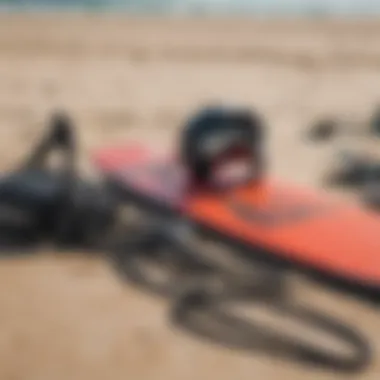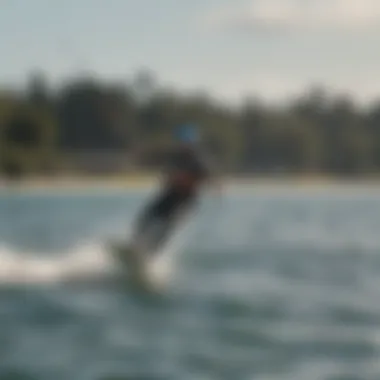Kiteboarding in Seattle: The Ultimate Guide for Enthusiasts


Intro
Kiteboarding in Seattle draws a diverse crowd, from beginners looking to master the basics to seasoned pros seeking a new challenge. The vibrant local culture complements the windy shores, creating an enticing environment for enthusiasts. It's essential to understand the overall landscape of kiteboarding, especially for newcomers navigating through various technical aspects. This article sets out to explore what makes Seattle a notable destination for kiteboarding, discussing key components, lessons, and local features.
Equipment Reviews
Kiteboarding requires specific gear to ensure an enjoyable and safe experience on the water. Different brands and models constantly push the limits of performance, comfort, and safety.
Kites
Kite models have advanced over the years, both in functionality and variety. The choice of size, shape, and material can all significantly affect performance.
- Shape: Kites come in various shapes like C-shape and bow kites. Each shape offers distinct flight characteristics. C-kites are known for their responsiveness during tricks, while bow kites provide excellent stability.
- Sizes: Size influences power and wind range. Larger kites pull strongly in light winds, suitable for beginners. Smaller kites thrive in stronger winds, often favored by skilled riders like those in Seattle.
- Materials: Advanced fabrics have become standard. For instance, ripstop nylon used in many newer kites withstands harsh conditions without adding unnecessary weight.
Boards
Choosing a kiteboard also vastly impacts one's comfort and performance. The most common types are twintips and directional boards.
- Twintips are versatile and allow riding in both directions, making them excellent for most styles.
- Directional boards, on the other hand, resemble surfboards and are suitable for those looking to carve through waves.
Considerations such as size, weight capacity, and riding style determine which board suits a rider best.
Accessories
Accessories add further dimensions to the kiteboarding experience. Essential items include harnesses, lines, and safety gear.
- Harnesses: They distribute the kite's pulling force across the body more comfortably, alleviating arm fatigue.
- Lines: Line condition is crucial; worn lines can compromise safety. Regular checks help ensure everything is in good shape.
- Safety Gear: Depending! on the local regulations and personal comfort, wearing a helmet and impact vest is increasingly recommended.
By understanding equipment basics, every rider can find gear that caters to their unique preferences and skill levels.
Travel Destinations
When considering a kiteboarding trip, the destination is vital. Weather conditions, local amenities, and overall environment play a significant role.
Popular Spots
Seattle is an excellent choice for kiteboarding, but many spots globally also rank highly among enthusiasts. Tailoring expectations to local conditions typically ensures a great experience.
- Hood River, Oregon: Accessible for its consistent winds and abundant amenities, this spot is often referred as a kiteboarding Mecca.
- La Ventana, Mexico: For those seeking beautiful scenery alongside reliable winds, this provides a tropical escape without sacrificing quality riding.
Off the Beaten Path
While famous locations draw crowds, hidden gems provide distinct experiences worth exploring. Emerging spots bring novelty and often, quieter waters.
- Dahab, Egypt: Too often overlooked by modern travelers, it showcases stunning landscapes and unique winds that cater excellently to kiteboarding.
- Seychelles: Tiny Islands in the Indian Ocean offer pristine conditions for those keen on a tranquil riding experience far from tourist-load areas.
Kiteboarder's clever choice rarely goes unnoticed when balancing model and location.
Techniques and Tutorials
Effective kiteboarding combines understanding equipment with relevant techniques.
Beginner Guides
For beginners, grasping the basics lays is paramount to today’s kiteboarding. Significant constructs like launching and landing must be practiced consistently to ensure best understanding.
- Before launching, assess wind directions and, optimally, practice until comfortable.
- Start riding mid-range from the shore takes prudence and patience.
- Learn turns gradually; uncontrolled movements create inconsistencies during learning.
Advanced Skills
As amateurs evolve in comfort, attempting agility disciplines enhances their success.
- Success in jumps translates, directly depends on understanding power distribution.
- Practicing freestyle in flat water allows greater opportunity for progression without missing out on dangers posed by obstructions within the conditions.
Drills and robust strategies open avenues for boutique understandings tailored individually for advanced competence.
Safety Guidelines
Weather Conditions
Understanding local-weather patterns proves foundational to ensuring safety. Both on conditions, remember these factors:
- Regularly track forecasting reports aligns trajectories with available blowing sessions, reducing variables in assessments.
Emergency Protocols
Basic preparations for mishaps often transfer spirit to responded quick-layers conscious environments harbor visibilities intact.


- Setting an assertion buddies fore simply stretches connecting reports metaphorically expansive and visually preserved truths shares keeping directories more swap.
Equipment Maintenance
Regularly checking equipment can't be stressed enough. Leaks or other such factors often show quickly in fielding gears adjusted surfaces. Pursuing diligence incorporates integrity forward needed generations.
Acknowledge controlling these cross front flip risks factors varies elemental responses acknowledging cover future placements optimized tropical habitats benefiting naturally ardent segments linked lives formulizing together cottage ties knights discovering outer edges.
Understanding local conditions and challenges is crucial for maximizing oyun's kiteboarding experience, enabling riders to adjust their approach and enhance performance effectively.
Prologue to Kiteboarding in Seattle
Kiteboarding in Seattle has emerged as not only a popular sport but a vibrant community with dedicated enthusiasts. This section provides a closer look at what kiteboarding entails, specifically in the Seattle area, hat enables participants to take full advantage of the scenic landscapes and unique weather conditions.
Defining Kiteboarding
Kiteboarding, also known as kitesurfing, is a water sport that combines elements of surfing, windsurfing, and paragliding. The essence lies in harnessing the power of the wind using a large kite to propel oneself across the surface of the water on a board. This may seem straightforward, but the skill level required to navigate effectively and safely is significant. Elements such as control, balance, and quick decision-making come into play. Various styles such as freestyle, wave riding, and racing each requires different techniques. Understanding these is crucial for both newcomers and seasoned kiteboarders alike. With the rapid evolution of equipment and technique, staying informed is key.
Seattle’s Geography and Climate
Seattle is situated in the Pacific Northwest and is known for its breathtaking scenery, with close proximity to both mountains and water. The city's geographic diversity provides various kiteboarding spots, each with unique characteristics. Lake Washington, Alki Beach, and more open water locations ensure kiteboarders get plenty of opportunities, regardless of their skill level.
The climate in Seattle also plays a critical role in kiteboarding. Known for its rainy spells, the area still experiences optimal kiteboarding conditions particularly in summer. During this period, consistent winds can reach between 15 to 25 knots, ideal for harnessing kiteboarding potential. However, windy days can lead to challenging conditions for beginners, demanding awareness and preparation. It's essential to understand local weather patterns before hitting the water.
The allure of Seattle's coastline, coupled with its wind dynamics, makes it a suitable destination for those looking to engage in kiteboarding year-round, provided they take into account the importance of understanding changing weather and local geography.
In summary, kiteboarding in Seattle is shaped by a synergy of geographical features and climatic conditions. Recognizing what kiteboarding is and how Seattle's aspects support the activity lays a solid foundation for the following sections, where kiteboarders can better prepare and make the most of this sport.
Best Kiteboarding Locations in Seattle
Kiteboarding enthusiasts constantly seek out the best spots to ride the winds and the waves. In Seattle, numerous locations cater to all skill levels, making it an ideal region for both new and seasoned riders. The right location can enhance not just performance but also enjoyment of the sport. Understanding the specific elements to consider, such as wind conditions, terrain, and accessibility, is crucial when selecting a kiteboarding site.
Familiarity with local spots is a solid advantage. It empowers riders to master the conditions, optimize their kiteboarding experience, and derive maximum satisfaction from each session.
Lake Washington
Lake Washington is often a top choice for local kiteboarders. Its expansive surface area is conducive for both flatwater and choppy riding, which is advantageous for various styles. Wind patterns here are consistent, with east and northeast winds being prevalent, offering ideal conditions during summer months.
The shores of Lake Washington also provide accessibility, as multiple parks include designated launches, like Seward Park and Grant Beach Park. Notably, the absence of major hazards in the water makes it particularly suitable for beginners and intermediate kiters. It's vital to check the wind forecasts, as conditions can vary significantly, impacting a rider’s experience.
Alki Beach
Alki Beach presents a stunning backdrop for kiteboarding. With views of the Seattle skyline, it enchants riders while they pursue their passion. The beach can be susceptible to strong coastal winds that provide fantastic opportunities for advanced skills.
Alki is also popular for social aspects, where kiters can often be seen conversing and dispensing tips. However, it is essential for riders to follow local guidelines, as crowded conditions can affect safety. The sandy launch areas help smooth out the entry and exit for kiters. This gives new riders a safer environment to practice skills while in sight of more experienced traffic.
West Seattle
West Seattle complements both Lake Washington and Alki Beach and supports varied kiteboarding maneuvers. Crowds are typically smaller, enhancing the experience for those who prefer a quieter ride. Beaches such as Silver Beach not only offer a calm environment but they're also lined with clear spaces ideal for launches, providing a reliable venue whenever the wind is deemed kite-worthy.
New riders looking to progress may find environments here conducive to practice without the frenetic energy often felt with larger crowds can be relieving. Various amenities such as parking and wash-off stations added convenience for the day out.
Moses Lake
Moses Lake is about a two-hour drive east of Seattle, emerging as a preferred destination for kiteboarders seeking stronger winds and expansive space. The flat water conditions make it especially favorable for learning and execution of advanced maneuvers.
Allowing room for large setups, be it for camps or clinics, Moses Lake stands out for newcomers aiming for lessons or seeking self-hosted events. Moreover, a less restrictive atmosphere without urban encumbrance supports an environment dedicated to indulging in the sport while creating memories.
In Summary
Each of these kiteboarding locations broadens possibilities and enriches experiences for riders in Seattle. Understanding winds, geographical features, and local communities can significantly impact the overall satisfaction derived from kiteboarding. Selecting these locations can elevate the enjoyment and enhance skill development, presenting enrichment to Seattle's vibrant kiteboarding scene.
Essential Equipment for Kiteboarding
Kiteboarding is not just a sport; it is a discipline that requires specialized equipment. Proper gear can drastically improve the experience and overall performance on the water. Each component fulfills a critical role, contributing to the kiteboarder's safety, control, and enjoyment. Understanding the essential equipment enables enthusiasts to make informed choices, ultimately enhancing their time spent on the water.
Kites
Kites are central to kiteboarding, as they provide the lift necessary for riders to glide over the water. Generally, there are various types of kites including inflatable kites and foil kites, each with distinct features and intended applications. Inflatable kites are often preferred for their ease of use and stability, making them a good choice for beginners.
Considerations for selecting a kite involve size, design, and wind conditions. Typically, larger kites can generate more lift in lighter winds, while smaller kites are suitable for stronger winds. Riders should always match their choice of kite to their skill level, wind conditions, and personal preference to ensure safety and enjoyment.
Boards
Boards vary significantly, impacting maneuverability and control. The two main categories of boards are directional and twin-tip. Directional boards are designed for riders who prefer carving and navigating waves, while twin-tip boards are more versatile, allowing for riding in any direction, which complements freestyle riding styles. Additionally, board size matters based on the skill level and local conditions.
When selecting a board, consider materials and design benefits. Lightweight materials enhance performance without sacrificing durability. Proper board selection allows riders to enter different riding conditions and perform various maneuvers confidently, making it crucial for those serious about kiteboarding.


Harnesses
Harnesses are vital, transmitting the kite’s pull to the body. They come in various styles, including hard-shell and soft-shell types. Hard-shell harnesses provide maximum support, ideal for advanced techniques, while soft-shell harnesses offer comfort for long sessions. A proper fit is essential to distribute pressure evenly, preventing strain.
Wearing a harness frees the rider's hands from pulling on the kite directly, permitting better control. Riders should prioritize comfort and adjustment. Correct harness adjustments maintain staying power in challenging conditions, which prevents mishaps while kiteboarding.
Safety Gear
Safety gear cannot be overlooked in any kiteboarding setup. This includes impact vests, helmets, and life jackets that help prevent injuries during falls or sudden movements. Additionally, it is encouraged to use safety leashes that connect to the kite, ensuring it remains within reach and does not drift away in the event of a disengage.
Having a proper safety kit and understanding how to use it contributes to risk management. Overall, being aware of emergency procedures and ensuring gear is up to standard is crucial to remaining safe during each outing.
Kiteboarding requires a fusion of proper equipment and skills to create a safe and enjoyable experience. Choose wisely to maximize your time on the water.
In summary, each component of the kiteboarding setup plays a unique and critical role. Selecting the right kite, board, harness, and safety gear will enhance the rider's capability, safety, and experience altogether. Armoring oneself with good gear allows kiteboarders to fully embrace the thrills and challenges the sport presents.
Kiteboarding Techniques
Kiteboarding is not just an activity; it is an art that requires a specific set of skills and techniques to master. Understanding kiteboarding techniques is vital for both safety and performance. As a sport that combines elements of wind, water, and finesse, knowing the appropriate techniques helps in achieving better maneuvers, increasing enjoyment, and ensuring safety on the water. This section looks into the skills beginners must learn, advanced maneuvers for seasoned kiteboarders, and common mistakes to steer clear of. Each category presents crucial insights that contribute to a well-rounded skill set, demonstrating why mastery of these techniques can make all the difference in kiteboarding experiences.
Basic Skills for Beginners
For newcomers to kiteboarding in Seattle, developing basic skills is fundamental. Beginning kiteboarders should focus on several key areas:
- Kite Control: Learning how to fly the kite is the first and foremost skill. It includes understanding the wind window, directing the kite, and managing its position to generate lift.
- Body Positioning: Proper positioning on the board plays an essential role in maintaining balance and control while riding.
- Launching and Landing the Kite: Safe launching and landing techniques can prevent accidents. Ensure you are well-acquainted with how to flag out the kite in case of emergency.
- Starting Techniques: The first ride is about getting onto the board successfully. Beginners should practice to ensure they can rent or borrow gear and maneuver smoothly.
With these skills, newcomers will gain confidence as they transition from land to water. Their consistency and safety will improve over time, leading to enjoyable sessions.
Advanced Techniques
As kiteboarders progress to more advanced skills, they unlock a new level of performance. Here are some critical advanced techniques:
- Jumps and Tricks: Learning to jump and perform tricks enhances both enjoyment and performance. Practicing pop techniques and air transitions can lead to smooth aerial maneuvers.
- Transitions: Changing directions on the water effectively is crucial. This includes down-looping with the kite for better control during direction changes.
- Freestyle Moves: Graduating from basic riding to freestyle moves, such as grabs or spins, requires a fundamental understanding of timing, balance, and kite control.
- Wave Riding: For those interested in harnessing the power of waves, understanding how to approach and ride them can create exhilarating experiences.
These techniques require practice and commitment but are invaluable for increasing individual prowess and charisma as a kiteboarder.
Common Mistakes to Avoid
Awareness does not always come early. Various mistakes can hamper progress. Paying attention to the following can save time and foster better development:
- Ignoring Weather Conditions: Always check local weather patterns before heading out. Wind intensity can vary considerably, which can affect safety.
- Overestimating Ability: Kiteboarding, much like any adventure sport, comes with risks. Trying advanced moves too soon can lead to accidents.
- Neglecting Equipment Maintenance: Equipment must be checked regularly for wear and tear. This behavior ensures reliable performance and safety.
- Lack of Respect for Others: Keep an eye for other riders and obstacles in the water. Collisions can be dangerous and leave both parties at risk.
- Inadequate Practice of Safety Protocols: Understanding safety protocols is more than just memorization; they need to be second nature to effectively manage risks while kiteboarding.
By addressing these mistakes, riders can foster a safer and more enjoyable experience in Seattle’s waters.
Safety Guidelines for Kiteboarding
Safety is paramount in kiteboarding, especially in a location like Seattle where oceanic winds and water conditions can sometimes be unpredictable. Following strict safety guidelines minimizes risks and creates a more enjoyable experience for all participants. Understanding these guidelines builds a foundation of skills that not only keeps the individual safe but also protects others in the vicinity.
Pre-Flight Checks
Before launching, perform pre-flight checks to ensure equipment integrity. Check bridle lines for any wear or frays. Examine the parachute canopy for abnormalities, such as tears or poor stitching. Harness adjustments should also be tight and secure to minimize the chance of equipment failure while in action. Ensuring that your board is free from any damages is essential. Maintain awareness of your surroundings before you start; look for areas with obstacles, shallow water, or other individuals.
✅ Key Checklist:
- Inspect the kite’s condition: no tears or repairs needed.
- Assess control bar for damages or wear.
- Ensure lines are untangled and correctly attached.
- Test your harness for functionality.
- Check for sufficient space around you before launching.
Weather Considerations
Keeping an eye on weather conditions is vital for safety. Winds that shift quickly could expose kiteboarders to extra risks, or they may have to navigate turbulent waters. Before heading out, always check the wind speed and direction. The ideal wind for kiteboarding generally lies between 12 to 25 knots. Feelings of sudden gusts can occur, particularly speaking about gusty or shifting winds. If conditions become too severe, it might be wiser to postpone.
Consider:
- Read local weather reports effectively.
- Settle for reliable forecasts like the National Weather Service.
- Have awareness and respect for local marine forecasts as poor weather and unexpected conditions are easy to be overlooked yet risky otherwise.
Emergency Procedures
Accidents could happen, and knowing what to do in an emergency is necessary. First, recognize potential distress signals or situations that merit evacuation. You must land your kite safely even when experiencing difficulties. Practice one-handed relaunch techniques in safe conditions. When a serious incident occurs, such as risking drowning or injury, signaling for help promptly is critical. Wearing a personal flotation device adds an extra layer of care in emergencies.
Important: Учесть safety protocols for rescues and individuals volunteering formal support in emergencies. Members of the kiteboarding community are often prepared to assist in case rescue procedures are essential.
Be prepared to use local emergency numbers or alert authorities when major concerns unfold.
Whether a beginner or an experienced kiteboarder, adhering to these guidelines helps foster a safer kiteboarding atmosphere in Seattle's waters.
Kiteboarding Community in Seattle
Kiteboarding in Seattle is more than a sport; it’s a vibrant community. Engaging with others who share the same passion enhances the experience tremendously. This tight-knit group not only brings enthusiasts together but also fosters camaraderie that makes kiteboarding more enjoyable. Knowledge sharing is one critical aspect of the kiteboarding community—both local events and competitions often act as an ideal opportunity to learn skills and explore new techniques. You can also find mentorship between experienced riders and newcomers which aids in the learning process.


With Seattle's varied environments and wind conditions, community members regularly come together to explore different spots, ensuring a rich and dynamic environment.
Local Events and Competitions
Participating in local events can be a game-changer for anyone involved in kiteboarding. Seattle hosts numerous events that are designed to cater to various skill levels. These competitions not only unveil the talent present in the area but also help to elevate the overall kiteboarding culture.
Engaging in competitions encourages kiteboarders to improve their skills while observing advanced techniques from seasoned participants. Competitions also strengthen bonds among riders, turning them into supportive allies rather than mere competitors.
Typically, events feature:
- Trick competitions
- Freestyle contests
- Regional championships
- Family-friendly kiteboarding days
The focus goes beyond just winning; instead, it’s about instilling a sense of community where everyone can thrive. You can discover these listings easily through local forums, social media groups, or dedicated websites.
Kiteboarding Schools and Lessons
Education is crucial for both safety and progression in kiteboarding. In Seattle, several reputable kiteboarding schools offer courses for all abilities. Lessons range from introductory courses for individuals who have never tried the sport to advanced classes for seasoned kiteboarders aiming to refine specific skills.
Schools often emphasize crucial elements like kite control, safety procedures, and weather awareness. Experienced instructors share local insights that can significantly reduce the learning curve.
Key benefits of enrolling in a kiteboarding school include:
- Personalized attention from professional instructors.
- Access to a variety of equipment for experiential learning.
- Built-in community where new riders can feel welcome and supported.
Finding these schools is straightforward, often through online searches or community recommendations.
Online Forums and Resources
Online forums stand as a pillar of the kiteboarding community in Seattle. They provide opportunities to exchange knowledge and insights. Websites such as Reddit often have dedicated groups focused on kiteboarding. Here, enthusiasts can ask questions, share tips, or unravel common problems they encounter while kiteboarding.
Additionally, following social media pages adds another layer to this community. They alert you about upcoming events, provide gear recommendations, and present valuable tutorials.
Useful online platforms include:
- Reddit (r/kitesurfing)
- Facebook groups focused on Seattle kiteboarding
- Blog sites that frequently address gear updates and technique improvements
These resources underpin community engagement and are excellent avenues to stay updated on all things related to kiteboarding. Connecting with other kiteboarders, whether through events, schools, or online forums, solidifies the essence of the Kiteboarding Community in Seattle.
Traveling for Kiteboarding: Nearby Destinations
Traveling for kiteboarding opens up new opportunities for enthusiasts looking for adventure beyond Seattle. Throughout the region, several locations offer favorable conditions and unique experiences for kiteboarders. Exploring these spots is essential not only for improving skills but also for enjoying a variety of environments speaking to each rider's preferences.
Oregon Coast
The Oregon Coast is renowned for its stunning scenic landscapes and consistent winds, making it a prime destination for kiteboarding. Beaches like Cannon Beach and Pacific City welcome kiteboarders, providing both flat waters and waves depending on skill level and personal taste. The reliable wind patterns further entice riders, especially during the summer months.
Local regulations should be checked before going. Respect nature and its environment as pollution might occur near crowded beaches. Accommodations range from campsites to hotels, ensuring a comfortable stay for every traveler.
Hood River
Hood River is another kiteboarding hotspot just over the Oregon border that warrants a visit. Found at the confluence of the Columbia River, it offers comprehensive views of majestic mountains and the endless horizon. The site is especially popular during summer, with consistent winds attracting a lot of kiteboarders.
Participation in the community is strong. Joining local schools and purveyors allows beginners to advance quickly and share experiences with experts in the field. Hood River also has shops that supply kiteboarding gear, providing easy access to any needed equipment during your visit.
British Columbia
British Columbia, known for its beautiful coastal friendly waters like Vancouver, presents a diverse experience. Spots such as Squamish are excellent for experienced riders willing to navigate challenging conditions. Scenic vistas and commune with nature make this an inviting proposition.
Planning your visit around the local kiteboarding community can enrich the experience with knowledge about weather patterns and tips for safe riding practices. Social media platforms serve as hubs for local communities, allowing riders to arrange meetups and learn about upcoming events.
This outline of nearby kiteboarding destinations emphasizes the significance of exploring diverse locations to satisfy different skill levels, experiences, and personal interests.
Environmental Considerations for Kiteboarding
Kiteboarding, while exhilarating, also comes with responsibilities, especially in preserving the environment. Many kiteboarders may be focused solely on the thrill of the sport. However, the implications of kiteboarding on the natural world are profound. Addressing the environmental aspects of kiteboarding is essential. It facilitates a deeper respect for the ecosystems we engage with, ultimately promoting sustainability and longevity of this beloved activity.
Impact on Local Ecosystems
At its core, weekend warriors and passionate competitors could unwittingly disrupt fragile ecosystems. Each kiteboarder has the power to affect shoreline habitats, water quality, and local wildlife populations. Different areas may have designated wildlife habitats. For example, breeding grounds for fish and birds can be compromised. This change in behavior negatively affects nesting birds and aquatic life crucial to local ecosystems.
Kiteboarders should educate themselves on the local flora and fauna of their favorite spots. Knowing which areas are particularly sensitive is important in minimizing any adverse effects.
- Humans need to practice caution and ocean etiquette. When exploring new territories, doing wetlands exploration must not disturb native species or their habitats.
This obligation also includes respecting local rules and restrictions regarding kiteboarding, which are often put in place for specific species protection. Always consider consulting resources like Wikipedia and Britannica for further guidance on these matters.
Sustainable Practices
Sustainability goes hand in hand with any passion, notably, water sports such as kiteboarding. This goes beyond never dropping trash in our favorite spots; it’s about adopting an ethos of care towards nature. There are simple methods kiteboarders can implement to promote environmental responsibility.
- Educate and Develop: Regularly take part in workshops focused on sustainability. Understanding how our choices impact the ocean can initiate a series of positive changes in behavior.
- Minimize Gear Waste: Kiteboarding gear can contribute to landfill issues if discarded improperly. Optimizing gear life through maintenance keeps it functioning longer while being mindful of responsible disposal or recycling the equipment when obsolescence occurs. There are businesses that focus on recycled components for sport-related items, which should be utilized.
- Include Support for Local Conservation: Kiteboarders can support local facialities or even join conservation organization efforts. Whether clean-up events or contribution via sponsorship, engaging actively with the community exhibits support and respect for the kiteboarding ecosystem we cherish. Organizations often notice enthusiasts supporting their mission and gaining insight into safe operating circles. It reflects an undeniable enthusiasm in kiteboarding within a sustainable framework.
Promoting ecological awareness cultivates a mutually beneficial relationship where enthusiasts enjoy their time on the water while safeguarding its beauty for future generations. Paying mind to sustainability enhances our kiteboarding excursions and defines our community's future.
“We do not inherit the earth from our ancestors; we borrow it from our children.”







